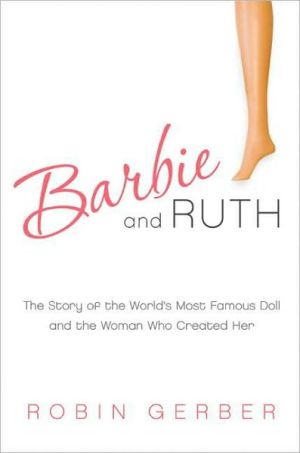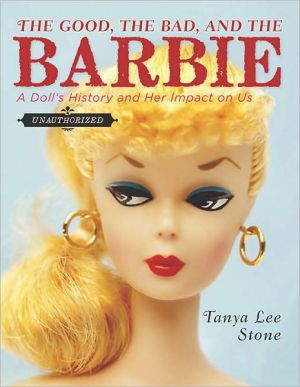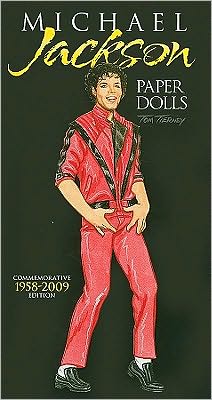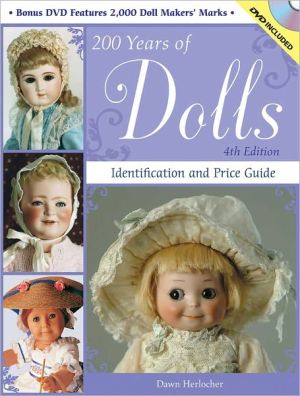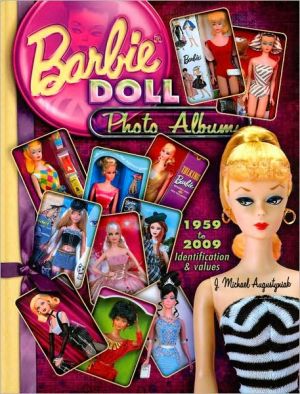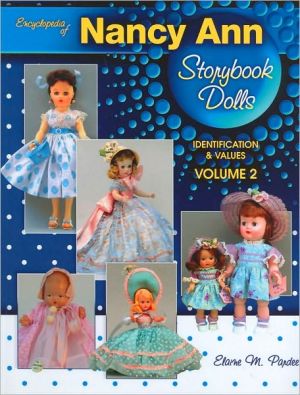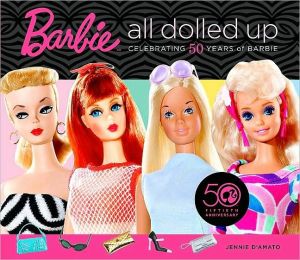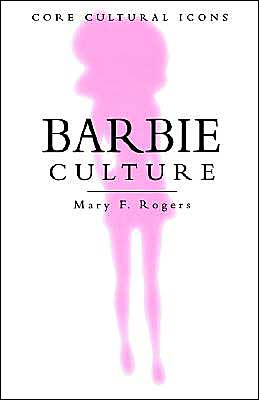Barbie and Ruth: The Story of the World's Most Famous Doll and the Woman Who Created Her
The tragic and redeeming story of how one visionary woman built the biggest toy company in the world and created a global icon.\ \ Barbie and Ruth is the entwined story of two exceptional women. There's Barbie: the diminutive yet arrestingly voluptuous doll unveiled at the 1959 Toy Fair who became the treasure of 90 percent of American girls and their counterparts in 150 countries. She went on to compete as an Olympic athlete, serve as an air force pilot, work as a boutique owner, run as a...
Search in google:
This is the entwined tale of two exceptional women. One was a voluptuous eleven-inch-tall beauty who debuted at the 1959 Toy Fair in New York City and quickly became the treasure of 9 out of 10 American girls and their counterparts in 150 countries. She went on to compete as an Olympic athlete, serve as an air force pilot, work as a boutique owner, run as a presidential candidate, and ignite a cultural firestorm. The other was Ruth Handler, the tenth child of Polish Jewish immigrants. A brilliant, creative, ruthless, and passionately competitive visionary, she was a mother and wife who wanted it all-a masterful entrepreneur who, together with her curvaceous plastic creation, changed American business and culture forever.Barbie and Ruth is the incredible, inspiring, tragic, and ultimately redeeming true story of how one extraordinary woman built the largest toy company in the world and created an enduring international icon.Publishers WeeklyJust in time for the 50th anniversary of Barbie is this behind-the-scenes look at her eccentric, determined inventor. Ruth Handler (1916-2002)was the ambitious and entrepreneurial 10th child of poor Polish immigrants. Disappointed with the unsophisticated dolls of the time, Ruth envisioned a doll that would allow young girls to act out their fantasies of the stylish young women they wanted to become. She modeled her creation on the Swiss doll "Bild-Lilli," a curvaceous plastic bombshell originally sold as a sex toy/gag gift and named her after her daughter Barbara. Handler fought indefatigably to establish herself in a male-dominated field, and history was made: 50 years later, Mattel is the biggest toy company in the world, and Barbie is sold at a rate of three dolls per second, worldwide. But Handler's rising star was short-lived; battered by breast cancer and convicted of shady business dealings in 1978, she wrenched her attentions away from Mattel and devoted herself to creating realistic, affordable prosthetic breasts for women who had lost one to a mastectomy. This stirring biography is a fine study of success and resilience. (Feb.)Copyright © Reed Business Information, a division of Reed Elsevier Inc. All rights reserved.
Barbie and Ruth\ The Story of the World's Most Famous Doll and the Woman Who Created Her\ Chapter One\ The Doll Nobody Wanted\ Little girls just want to be bigger girls.\ —Ruth Handler\ Ruth Handler could sell anything. In 1959 she arrived in New York for the nation's Toy Fair, confident that she could sell a new doll she had created. She had been fighting naysayers, however, for seven years. The doll was a terrible idea, they had told her.\ As the forty-three-year-old executive vice president of Mattel, Inc., Ruth had created an industry upstart in 1944 that was now the third biggest toy company in America. Mattel, based in Hawthorne, California, just outside Los Angeles, was a $14 million business. Ruth, a petite 5-foot2 ½-inch hard charger with a quick smile and quicker temper, had tripled the size of the business since the start of the decade. With her husband, Elliot, as chief toy designer, she had outmarketed and outmanaged her chief rivals, Louis Marx and Company, and Kenner Products. Her revenues would soon exceed theirs.\ Ruth headed straight for the New Yorker Hotel, where a room had been converted into display space. So many companies came to Toy Fair with so many toys to display that they overflowed into hotels neighboring the main hall. Beds, chairs, and desks were all carted out to make room for elaborate displays like the one for Ruth's doll.\ Ruth dressed that morning to look sharp and show off her slender waist and full bust. Moving restlessly around the room, she adjusted and scrutinized each twelve-inch scaled scene, no doubt thinking about what was at stake. She had ordered a hugeamount of inventory from her Japanese manufacturers. Twenty thousand of her petite-size fashion dolls were on weekly order, along with forty thousand pieces of the various outfits that had been designed to fit the doll's tiny, voluptuous figure. But the cost of moving that inventory onto and off store shelves was not all that was on Ruth's mind.\ Ruth was also worried about her credibility. She had founded the company, and the men in her mostly male industry gave her credit for brilliance as an entrepreneur. But she had never invented or designed a toy. She also possessed the sometimes irrational optimism that fuels leaders and allows little tolerance for failure. Even though her designers told Ruth many times that making this doll profitable would be impossible, she pushed it through anyway.\ Ruth lit one cigarette off the last. She barked orders laced with four-letter words and swiped at specks of dust. Her bravado hid another more personal reason that made this toy important to her. For her, this doll was more than a plaything. She was determined to make the buyers understand that this small plastic toy had a giant place to fill in the lives of little girls.\ Toy Fair shimmered with all the hype and hoopla of a three-ring circus and a Broadway show rolled into one. The extravaganza was about innovation, design, a touch of genius, and companies betting on hitting the cultural zeitgeist. Toy manufacturers, intent on mesmerizing retail store buyers, spilled out of the main convention venue, the Toy Center at 200 Fifth Avenue, a legendary address in the history of toy making. Built just after the turn of the twentieth century, the building saw tenants move in as World War I ended and the center of toy manufacturing moved from Germany to the United States.\ Large, gaudy banners draped the entrance to the fair. Adults promenaded in character costumes, and toys blinked, whirled, and stared from elaborate displays. Child's play cloaked the serious business of making toy sales. Nearly seven thousand retail buyers milled around 200 Fifth Avenue on an unseasonably warm day. New items at the 1959 fair included a working child-size soda fountain, a walking hobbyhorse, a gas-operated car that could go as fast as 22 miles per hour, and a Dr. Seuss zoo.\ Starting in 1903, toy companies had arrived at Toy Fair to unveil their inventions and try to grab the attention, and shelf space, of store buyers. The first fair had been held near the docks to accommodate toys imported from Europe. That year, the American toys included the Humpty Dumpty Circus, Crayola crayons, Lionel trains, and teddy bears, supposedly named for the president who had refused to kill an orphaned bear cub.\ Before Toy Fair started, the media had ignored Ruth's doll. With the space age dominating Americans' imaginations, the New York Times focused on Mattel's two-stage, three-foot-long plastic rocket, which could shoot two hundred feet into the air. Jack Ryan, a former project engineer on the U.S. Navy's Sparrow missile project, was lured from a job at Raytheon Company to design the miniature missile. Mattel had the trappings of a major aircraft company, with its own research and development department and twenty graduate engineers with a large budget to dream up the next hot toy. Picked for their unique creativity and fierce competitiveness, they were called the blue-sky group, and they were expected to think two to four years into the future.\ A toy like the plastic rocket would be sent to a team of ten industrial engineers, who planned the production. "On a new item," Ruth explained to a reporter, "we will run as many as a hundred cost sheets before we fix on a design." She had boundless faith in the management and productions systems she had designed. Mattel's factories were more mechanized and its costs more refined than any of its competitors. With typical grandiosity, Ruth told the New York Times, "With our system we might just as well be turning out real airplanes or missiles." Instead, fueled by Elliot's genius for invention, Ruth sold toys to a postwar marketplace starved for them.\ Barbie and Ruth\ The Story of the World's Most Famous Doll and the Woman Who Created Her. Copyright (c) by Robin Gerber . Reprinted by permission of HarperCollins Publishers, Inc. All rights reserved. Available now wherever books are sold.
Introduction vii1 The Doll Nobody Wanted 12 The Tenth Child 213 Love at a Nickel a Dance 294 Ruth and Elliot and Matt 435 A Working Mother 616 Uke-A-Doodles 717 Music Makers and Sour Notes 798 Gambling Everything on Mickey Mouse 919 The Woman and the Doll 10310 Soaring in the Sixties 11911 Toys, Money, and Power 13512 Hot Wheels and Hot Deals 14713 The Cancer Within 16514 The Plot Unravels 18515 Nearly Me 19716 The Wages of Fraud 21317 Forced Service 22518 Ken and a Time of Plague 23319 Her Way 245Author's Note 255Bibliography 258Acknowledgments 267Index 269
\ Publishers WeeklyJust in time for the 50th anniversary of Barbie is this behind-the-scenes look at her eccentric, determined inventor. Ruth Handler (1916-2002)was the ambitious and entrepreneurial 10th child of poor Polish immigrants. Disappointed with the unsophisticated dolls of the time, Ruth envisioned a doll that would allow young girls to act out their fantasies of the stylish young women they wanted to become. She modeled her creation on the Swiss doll "Bild-Lilli," a curvaceous plastic bombshell originally sold as a sex toy/gag gift and named her after her daughter Barbara. Handler fought indefatigably to establish herself in a male-dominated field, and history was made: 50 years later, Mattel is the biggest toy company in the world, and Barbie is sold at a rate of three dolls per second, worldwide. But Handler's rising star was short-lived; battered by breast cancer and convicted of shady business dealings in 1978, she wrenched her attentions away from Mattel and devoted herself to creating realistic, affordable prosthetic breasts for women who had lost one to a mastectomy. This stirring biography is a fine study of success and resilience. (Feb.)\ Copyright © Reed Business Information, a division of Reed Elsevier Inc. All rights reserved.\ \ \ \ \ Library JournalThe impact of Barbie on U.S. popular culture rivals even that of Mickey Mouse, so it is particularly surprising that this is the first full-length biography of the indomitable woman who brought Barbie to life. Born to Polish-Jewish immigrants in 1916, Ruthie Mosko faced appalling anti-Semitism and sexism in her climb to the pinnacle of corporate power. With her husband, Elliot Handler, she cofounded and built Mattel into a multimillion dollar corporation, introducing Barbie (named after their daughter) in 1959. Ruth and her husband were later forced out of Mattel by charges of fraud (accounting irregularities) to which Ruth pleaded no contest. Breast cancer and a radical mastectomy led to her next career: she founded Ruthton, a company devoted to manufacturing breast prosthetics. In addition to her already extensive charity work, Ruth devoted countless hours to assisting her fellow "mastectomees" and to fighting the shame and stigma then associated with the surgery. Using interviews and primary-source materials, Gerber (Katharine Graham) presents a long-overdue study of a complex woman whose career covered a spectrum from alleged criminal behavior to humanitarian work. Recommended for all libraries.\ —Tessa L.H. Minchew\ \ \ \ New York Post"Gerber’s smoothly-written biography paints a fearless business woman as a devoted wife, a too-busy mother and a rock-‘em-sock-‘em executive."\ \ \ \ \ Time magazine“Barbie and her creator, the sharp-elbowed gal who built the biggest toy company, have a story to tell.”\ \ \ \ \ Time Magazine"Barbie and her creator, the sharp-elbowed gal who built the biggest toy company, have a story to tell."\ \
